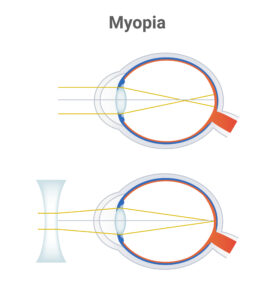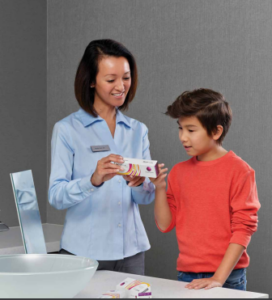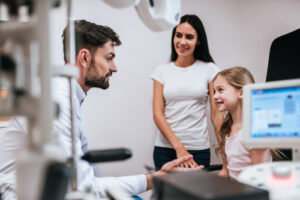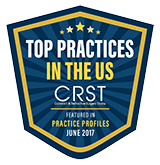Myopia, or nearsightedness, is a common eye condition often diagnosed in childhood. Children and adults with myopia often need prescription glasses or contact lenses to correct their vision.
However, myopia can become more severe over time. This usually happens in children, as their eyesight is still changing as they continue growing.
As a result, their eyesight will progressively worsen until it stabilizes once they’re fully grown. Luckily, there is a way to minimize how much a child’s myopia will increase, and that’s through myopia treatment.
Myopia treatment is an effective method that reduces myopia progression, making it less likely that the patient will have severe myopia by the time they’re an adult. To better understand how myopia treatment works, let’s first discuss how myopia can affect your child’s vision.
What is Myopia?

Myopia is a very common refractive error. It’s more common than hyperopia (farsightedness) and astigmatism.
Refractive errors occur when the shape of the cornea is not as it should be. An elongated cornea causes myopia.
In children, myopia tends to get worse as the cornea can continue to elongate. A more elongated cornea often occurs due to too many stimuli from sources like digital screens.
Using computers, smartphones, and tablets can take their toll on children’s eyes and ability to see. It may not seem like severe myopia is an issue since modern technology allows glasses and contact lenses to correct even extreme refractive errors.
Still, there are consequences to being very nearsighted. Severe myopia increases your risk for cataracts, glaucoma, and retinal detachment as an adult. Treating myopia in children can lower these risks by preventing especially severe myopia.
Myopia Treatment

Myopia treatment is for nearsighted children between the ages of 8 and 15. The traditional treatment for people with myopia, regardless of age, is corrective lenses, either glasses or contact lenses.
But these visual aids don’t prevent further elongation of the cornea and worsening myopia. Between ages 8 and 15, nearsighted children experience the most myopia progression.
Their myopia can get significantly worse during this time. That’s why this is the best time to intervene to slow or stop further elongation of the cornea.
The good news is there’s a proven method for myopia treatment, with clinical trials showing a reduction of 59% in myopia progression called MiSight Contact Lenses. Williamson Eye Center is pleased to offer myopia management to patients in the Greater Baton Rouge area.
MiSight Contact Lenses

MiSight contact lenses are contact lenses that correct myopia. Although traditional contact lenses can also correct myopia, MiSight contact lenses are different.
In addition to correcting vision, MiSight contact lenses can simultaneously slow down myopia progression. This is due to the design of the lenses.
Each MiSight contact lens is divided into different zones: two for controlling myopia and two for correcting it. The central part of the lens corrects your vision, while the peripherals, which are the edges of your vision, have alternating rings that both correct myopia and control it.
The part of the lens that controls myopia works by focusing light directly in front of the retina. Refocusing light in this way has been shown to reduce the stimuli that cause the cornea to grow longer.
By reducing this elongation, MiSight contact lenses slow myopia progression, so by the time patients are adults, their myopia hasn’t become more severe.
MiSight contact lenses are daily disposable lenses. To be effective, they need to be worn consistently. Children will need to wear them daily, likely for several years.
Treatment should begin when a child is between 8 and 12 but can continue until the child is 15. MiSight contact lenses are most effective when used for as long as possible.
Choosing Myopia Treatment For Your Child

If your child has myopia, it’s in their best interest to consider myopia treatment. Myopia treatment can improve your child’s life and reduce the risk of several eye conditions as an adult.
Glaucoma and retinal detachment especially can be very difficult to manage, and many patients who suffer from these conditions end up with permanent vision loss. Investing in myopia treatment for your child now can save them vision loss when they’re much older.
You should talk to your eye doctor and child when considering myopia treatment. Have an open and honest conversation with your child so they, too, understand the risks of myopia progression.
MiSight contact lenses need to be worn consistently, so your child must understand what’s expected of them if you both decide to undergo myopia treatment. If your child is unwilling to wear their MiSight contact lenses as directed, myopia treatment will not work as it should.
Explaining myopia and myopia progression to your child can be challenging, but we can help. Our specialists can help you and your child to understand everything you need to know about myopia treatment and assess your child for treatment.
If your child looks like a good candidate for treatment, we can get you started with a prescription for MiSight contact lenses. Learn more by scheduling an appointment at Williamson Eye Center in Baton Rouge, LA, for a consultation.



